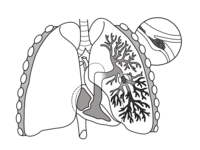
Photo from wikipedia
BACKGROUND Comparison of radiography to magnetic resonance imaging (MRI) can help objectively assess the value and limitations of radiographs in orthopaedic disease processes. The tarsus and proximal suspensory origin of… Click to show full abstract
BACKGROUND Comparison of radiography to magnetic resonance imaging (MRI) can help objectively assess the value and limitations of radiographs in orthopaedic disease processes. The tarsus and proximal suspensory origin of the metatarsus are commonly imaged regions for lameness. The knowledge gained by comparison between imaging modalities will aid in improving accuracy of radiographic interpretation. OBJECTIVE To compare the radiographic and MRI findings of the proximal third metatarsal bone (MTIII) and proximal suspensory ligament, using MRI as the gold standard. STUDY DESIGN Retrospective observational study. METHODS Single hindlimbs of 35 horses with radiographic and high-field (3Tesla (3T)) MRI studies were blindly evaluated by two board-certified veterinary radiologists and a radiology resident. Severity and location of the following parameters were assessed: radiographic MTIII sclerosis and lucent regions, MRI endosteal metatarsal sclerosis and bone marrow lesions, plantar cortical proliferation and resorption, and proximal suspensory desmopathy (PSD). RESULTS Radiographic osseous changes of MTIII were identified in 54% of limbs, whereas 40% limbs had osseous changes on MRI. 43% of limbs had PSD on MRI. No significant association was found between the presence of radiographic changes in MTIII and PSD on MRI (P=0.7). A statistically significant association and positive correlation was found between the severity of radiographic changes and MTIII plantar cortical proliferation and resorption on MRI (P=0.01). MAIN LIMITATIONS Retrospective study with no histopathology. Ability to correlate findings with lameness was limited by the lack of standardised time intervals between onset of lameness, diagnostic analgesia, and advanced imaging. CONCLUSION Radiographic bony changes of proximal MTIII do not reliably predict presence or severity of PSD but are associated with osseous changes at the proximal MTIII. The presence of radiographic changes should warrant additional diagnostics in the region prior to making conclusions about the presence or absence of PSD.
Journal Title: Equine veterinary journal
Year Published: 2022
Link to full text (if available)
Share on Social Media: Sign Up to like & get
recommendations!